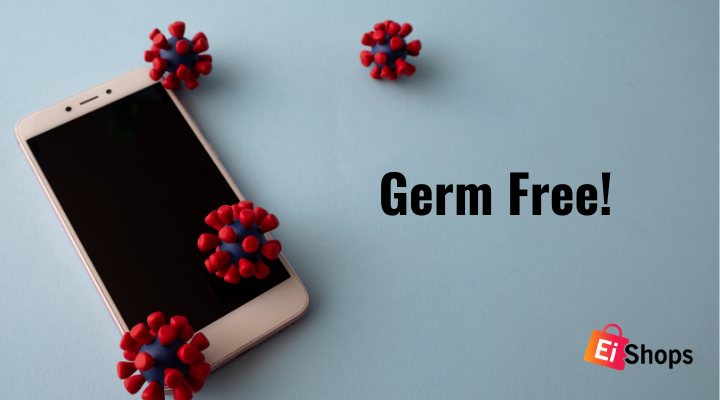Strategies to keep the phone germ free

Public transport, elevator buttons, doorknobs, railings, other frequently touched objects and surfaces: it's very hard to avoid germ-infected surfaces in our daily lives, which is why it's strictly advised to wash your hands thoroughly and regularly.
However, there is no way to guarantee that all public surfaces are regularly and effectively sanitized to disinfect, but there is one surface that frequently comes in contact with our hands and face, and we do have control over to stop the germ spread: our Phones. Yes – beyond our faces, a cell phone is the thing we touch all the time.
Get to Know the Hard Facts First
Studies show that our smartphones are covered in 25,000 bacteria per square inch, making it one of the dirtiest objects in our daily routine. In fact, the cell phone is the leading dirtiest object out of the Dirty or filthy objects list.
An inspection revealed the following serious pathogen-count found on different surfaces leading the cell phone.
Mobile phone: Over 25,000 bacteria per square inch
Doorknob: over 8,500 bacteria per square inch
Grocery Store Checkout screen: 4,500 bacteria per square inch
Pet food dish: 2,110 bacteria per square inch
Toilet seat: 1,201 bacteria per square inch
Kitchen counter: 1,736 bacteria per square inch
The statistics show that a cell phone harbors more than three times the number of germs that a dirty doorknob does. Research has varied on just how many germs live on an average cell phone, but a recent study shows more than 17,000 bacterial genes survive on the phones. The health officials are now putting more emphasis on ensuring that your tech gadgets must be as clean as possible to reduce the spread of germs.
How to Clean your Phone?
SroresGo tell you the best following ways to clean your phone while avoiding any unnecessary damage to the device. Always start cleaning by turning your phone off and ensure to leave it to get completely dry before turning it back on. It is also advised to you to clean your phone daily.
Apple and Google have also given guidelines on their support page to keep the smartphone germ free. Apple has suggested wiping the phone's display and back panel with a dry clean towel soaked in warm water. However, according to Google, there is no problem cleaning the phone with a mixture of low-alkaline soapy water.
Apple or Android smartphones – iPhone 11, iPhone 11 Pro, iPhone 11 Pro Max, Galaxy S7, Galaxy S7 Edge, Galaxy S8, Galaxy S8 Plus, Galaxy S9, Galaxy S9 Plus, Galaxy S10, Galaxy S10 Plus, Galaxy 3, Galaxy Fold, and the Pixel 4 can be easily disinfected by using the following method.
- Unplug all cables like data cable, handsfree or headphones.
- Always switch off your phone when you need to make it germ-free.
- If you’ve covered your phone with a rear case, then it's advised to remove it off to cleanse your phone properly.
- Wipe off the front and back surfaces with a soft, slightly damp, lint-free cloth.
- If your phone still needs further cleaning, gently use a microfibre cloth dipped in the mixture of water and soap to wipe around the phone.
- Wipe off the excess water on the phone with another dry cloth and be careful about getting moisture in openings.
- If you want to clean the bean tray and Sim card, open it and clean it with a thin cotton bud soaked in soapy water.
- Let your phone and bean tray completely air dry for up to 5 minutes.
- Wipe down with a paper towel or microfibre again to get the crystal-clear finish back.
- Repeat the steps from 4-9, excluding step 7 for cleaning your phone case.
Safest Ways to Clean your Phone
- Dis-infecting Wipes
All products, according to Apple, can be gently cleaned with 70% isopropyl alcohol cleaning wipes. The SroresGo’ disinfecting wipes and other common disinfectants won't affect the screen quality and are safe to use on your phone. Wiping the hard, nonporous surfaces with alcoholic wipes, like the display screens, keyboard, or other exterior surfaces, effectively kills germs.
- Kill germs with mild soapy water
You can also try a mixture of mild soap and water applied to a microfiber cloth, avoiding soaking your phone in soapy water at any cost because this can seriously damage its internals. Use a lint-free cloth as it is less abrasive than tissues and towels and is less likely to damage the sensors and scratch the protective layer of your phone.
- A light rinse to waterproof models
If you have got a real waterproof smartphone like Samsung Galaxy S9, S10 that can be immersed in up to 1.5 meters of water for half an hour and iPhone 11 that can withstand immersion in up to 2 meters for 30 minutes, then you can flush away all the germs by giving a light rinse.
Don’t Use Harsh Chemicals on Your Phone
Be careful while using the cleaners for your phone. Apple warns users to avoid strong commercial cleaning supplies and other domestic cleaning agents like bleach as they can damage the fingerprint-resistant coatings on its screens and possibly scratch the glass fronts, while Samsung has published the same warnings for its popular Galaxy models.
- Never spray anything directly on your smartphone display.
- Avoid oversaturating your phone with cleaning solutions.
- Do not use the cleansers with scrubbing power.
- Opt for a gentler lint-free cloth instead of wiping your phone with a kitchen towel or any other harsh material.
How Often Should You Clean Your Phone?
You don't need to go for a deep clean every day, but a quick wipe down of your smartphone with a microfiber cloth is most effective to sterilize it from the possible germs count. The experts recommend deep cleaning at least twice a week but try to wipe away the phone screen grime every other day.